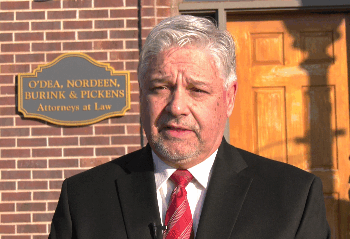RIVER, Mich. (WZMQ) – Last summer, Rapid River business owners began discussions about a multi-million dollar project that would involve bringing electric vehicle charging into town, as well as improving the place locals know and love. Sunday evening, the Rapid River Development Committee invited the community to hear the latest updates to the project.
“We have about 19,000 vehicles that travel right through Rapid River every day, and more and more of those are electric,” said Rapid River Development Committee Chair Caleb Booth.
To keep those electric vehicles running, the Development Committee has been looking into the possibility of bringing electric vehicle charging stations to Rapid River.
“Charging a vehicle takes a little bit longer than filling up with gas, so this creates a perfect opportunity for our local businesses to take advantage of that,” Booth said.
The other part of the project—established at previous meetings—involves a facelift for Rapid River, which would be achieved through upgrades like once again lighting up the sign atop Jack’s Restaurant.
The newest addition to the plan is the Beacon Project, which would “reenergize” the current Lions Club building and generate power for the electric vehicle charging stations.
“We are currently in negotiations with the Lions Club…to turn it into a new home for the Lions Club, as well as a community center for the residents of Rapid River,” said Booth. “One of the cool things we have available to us is a new technology called a microgrid. It involves renewable energy that gets channeled into a battery that would be centrally located that would then power those chargers to power those electric vehicles.”
That renewable energy would be obtained through solar panels.
“The great portion of the solar panels will be on the new building,” said Jack’s Restaurant owner and Development Committee member Bobbi Ryan. “One of the biggest fears that everybody has is, ‘Is this going to change Rapid River or change who we are?’ No, it’s not. It’s not going to change Rapid River being unique. That’s my big fight in this.”
According to Booth, the project has received support from Governor Gretchen Whitmer’s office, the DNR, MDOT, the Central Upper Peninsula Planning & Development Regional Commission, the Ford Fund, and other organizations. Ford Pro representative and project lead Christian Kreipke addressed attendees’ concerns about the environmental impact of a microgrid.
“‘Is this thing going to leak out battery acid everywhere?’ The answer is no,” Kreipke said. “The new technology utilizes saltwater. You’re looking at a tank that would be roughly about 10 feet by 20 feet, and it’s specifically designed with five layers of plasma… Even if some disaster happened and the whole thing busted open, this plasma can’t get into the water because it doesn’t break down into a fluid.”
Kreipke says the technology also accounts for Rapid River’s climate, saying it can get by on three hours of sun per day.
“What happens if we go our usual Michigan winter with 60 days in a row with no sun?” he asked. “Between wind and the storage capacity of this, we are covered.”
Another bonus according to Kreipke is that the microgrid is bidirectional, meaning it taps into the primary power grid.
“If we generate more electricity than we need, we can sell that back to the electric company,” he said.
The project would be primarily funded through grants. While he could not give an exact price at this stage, Kreipke says the cost would be in the double-digit millions. A local himself, he believes it would be a tremendous benefit for Rapid River, while also serving as a model for similar projects in other states.
“People are looking to us to be the beacon for small towns all across the nation,” said Kreipke.
The project would be rolled out in phases, with the first phase likely getting underway in the next few months. The Rapid River Development Committee hopes to break ground on the Beacon Project in September.
Click here for WZMQ 19’s coverage of the first meeting on this project in 2023. For more information on the logistics and cost of the project, click here.

















